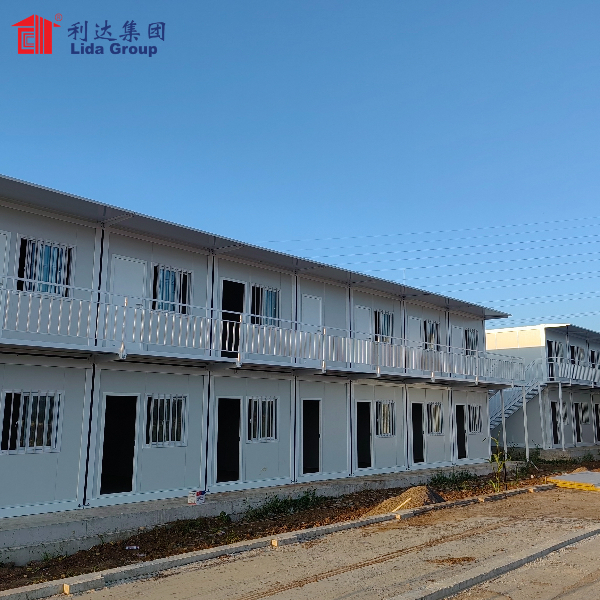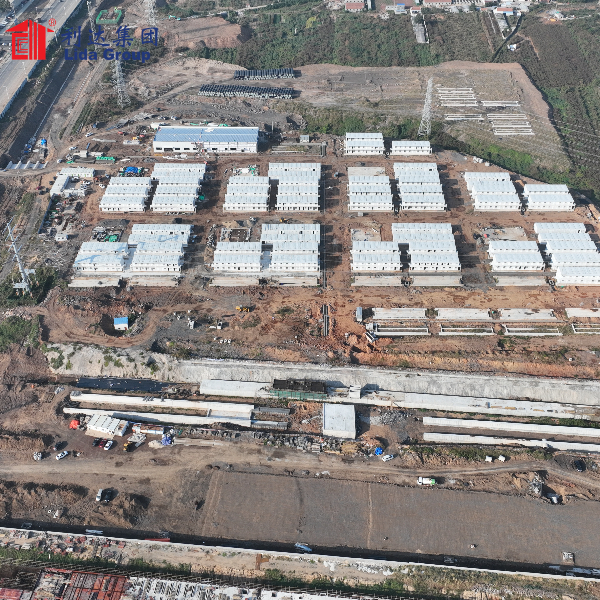In the modern world, the demand for efficient housing solutions for temporary labor camps has grown significantly. As industries expand into remote areas and seek to accommodate large workforces, traditional construction methods often fall short in terms of speed, cost, and adaptability. Flat pack container houses have emerged as a viable alternative, offering innovative solutions tailored to the unique needs of labor camps. This article explores the efficiency of flat pack container houses, focusing on their features, benefits, and applications in labor camps.
Understanding Flat Pack Container Houses
What Are Flat Pack Container Houses?
Flat pack container houses are modular structures made from repurposed shipping containers designed to be easily transported and assembled. These containers are modified and outfitted with essential amenities to create livable spaces, making them ideal for temporary housing solutions. The flat pack design allows for efficient shipping and rapid assembly, which are critical factors in labor camp settings.
Key Features of Flat Pack Container Houses
- Modular Design: The modularity of flat pack container houses allows for easy customization and reconfiguration based on specific needs, whether for individual workers or larger groups.
- Rapid Assembly: One of the most significant advantages of flat pack container houses is their speed of assembly. These homes can be set up in a matter of days, greatly reducing the time required to provide housing solutions.
- Transportability: Flat pack container houses can be easily transported to remote locations, making them ideal for labor camps situated far from urban centers.
- Durability: Shipping containers are designed to withstand harsh environmental conditions, ensuring that flat pack houses remain sturdy and reliable in various climates.
- Cost-Effectiveness: Utilizing repurposed materials helps keep costs low, making flat pack container houses an affordable option for companies needing temporary housing.
The Importance of Efficient Housing Solutions in Labor Camps
1. Addressing Accessibility Challenges
Labor camps are often situated in remote locations where traditional construction methods are impractical:
- Limited Infrastructure: Many remote areas lack the necessary infrastructure for traditional building projects, such as reliable access to utilities and transportation routes. Flat pack container houses can be quickly deployed and set up, addressing immediate housing needs.
- Emergency Situations: In times of crisis, such as natural disasters or sudden workforce demands, the ability to rapidly assemble housing is critical. Flat pack container houses provide a swift and effective solution.
2. Enhancing Worker Comfort
Comfortable living conditions are essential for worker morale and productivity:
- Modern Amenities: Flat pack container houses can be equipped with essential amenities such as kitchens, bathrooms, and comfortable sleeping areas, allowing workers to feel at home even during temporary assignments.
- Privacy: Individual or shared units can be designed to provide adequate privacy, allowing workers to unwind after long shifts in a personal space that fosters relaxation.
3. Supporting Workforce Mobility
Many industries require a mobile workforce that can adapt to changing demands:
- Flexible Housing Solutions: Flat pack container houses can be easily relocated as projects move or as workforce needs change, providing a practical solution for companies operating in dynamic environments.
- Temporary Accommodations: These homes can serve as temporary housing for workers during specific projects or seasons, reducing the need for permanent construction.
The Design and Construction Process
1. Planning and Needs Assessment
The success of flat pack container housing begins with thorough planning:
- Understanding Client Needs: Engaging with clients to assess their specific requirements, including the number of occupants and desired amenities, is crucial for effective design.
- Site Evaluation: Evaluating the site for accessibility, environmental conditions, and available resources helps inform the design process.
2. Modular Production
Once the design is finalized, the construction process begins off-site:
- Factory Production: Modular units are constructed in a controlled environment, allowing for precision and quality control. This typically involves modifying shipping containers to include insulation, windows, doors, and plumbing.
- Quality Assurance: Each unit undergoes rigorous inspections to ensure safety and quality standards are met before being transported to the site.
3. Transportation and Assembly
The next phase involves transporting the flat pack units to the construction site:
- Logistics Management: Coordinating transportation logistics is essential to ensure that units arrive on time and in good condition.
- On-Site Assembly: Once on-site, the units can be quickly assembled into the desired configuration, often within days, thanks to the modular design.
4. Final Touches
After assembly, the final steps include:
- Interior Finishing: Adding furnishings and appliances ensures that the flat pack container houses are ready for occupancy.
- Site Preparation: Ensuring that the surrounding area is safe and accessible for occupants, including landscaping and utility connections.
Benefits of Flat Pack Container Houses in Labor Camps
1. Flexibility and Customization
Flat pack container houses are designed with flexibility in mind:
- Customizable Configurations: Clients can choose layouts that best suit their workforce, including options for individual units or shared accommodations. This adaptability makes it easy to create spaces that meet specific functional requirements.
- Expandable Designs: As the workforce grows or changes, flat pack container houses can be easily expanded or reconfigured, allowing for growth without the need for extensive renovations or new construction.
2. Cost-Effectiveness
Investing in flat pack container houses can lead to substantial cost savings:
- Lower Initial Investment: The use of repurposed shipping containers significantly reduces material costs, making flat pack homes a budget-friendly option for companies.
- Operational Savings: Improved worker satisfaction and reduced turnover can save companies money in the long run, as happy workers are more productive and less likely to leave their positions.
3. Sustainability
The commitment to sustainability is a significant advantage of flat pack container houses:
- Eco-Friendly Materials: By repurposing shipping containers, Lida Group significantly reduces waste associated with traditional construction methods. This approach aligns with growing environmental concerns and the need for sustainable practices.
- Energy Efficiency: Many flat pack homes are designed with energy-efficient systems, such as high-quality insulation and solar panels, which help lower utility costs and reduce environmental impact.
Applications of Flat Pack Container Houses
1. Worker Accommodation
Flat pack container houses are ideal for labor camps in various industries:
- Immediate Housing Solutions: These homes provide quick accommodation for workers involved in large-scale projects, ensuring comfortable living conditions.
- Adaptable Designs: The modular nature allows for easy reconfiguration based on changing workforce needs, making them suitable for both temporary and long-term use.
2. Educational Facilities
Container houses can also serve as educational facilities:
- Classrooms and Administrative Offices: Lida Group can create flexible classroom spaces and administrative offices that meet the needs of educational institutions, particularly in remote areas.
- Affordable Solutions: The cost-effectiveness of flat pack homes makes them an attractive option for schools seeking to expand their facilities.
3. Healthcare Facilities
The healthcare sector can benefit significantly from flat pack container houses:
- Temporary Clinics: In times of crisis, such as pandemics or natural disasters, these homes can be quickly deployed as temporary clinics or vaccination centers, ensuring communities have access to essential services.
- Long-Term Facilities: Permanent healthcare facilities can also be constructed using sustainable methods, ensuring they meet community needs efficiently.
4. Disaster Relief
Flat pack container houses play a vital role in disaster relief efforts:
- Rapid Deployment: After natural disasters, flat pack homes can be quickly assembled to provide temporary housing for displaced individuals and families.
- Flexible Solutions: They can be customized to meet the specific needs of affected communities, ensuring adequate shelter is available during recovery efforts.
Case Studies: Successful Flat Pack Container House Projects
Case Study 1: Worker Accommodation for Construction
Challenge: A major construction company needed a labor camp to accommodate workers on a large infrastructure project.
Solution: The company opted for flat pack container houses designed by Lida Group, featuring modern living units and communal facilities.
Outcome: The project was completed ahead of schedule, and worker satisfaction significantly improved, leading to increased productivity and reduced turnover rates.
Case Study 2: Educational Facility Expansion
Challenge: A local school district needed to expand its facilities to accommodate a growing student population.
Solution: Lida Group provided flat pack container classrooms that could be easily assembled on-site, providing additional space for learning.
Outcome: The new classrooms were ready for occupancy in a fraction of the time it would have taken for traditional construction, allowing the school to meet its needs promptly.
Case Study 3: Disaster Relief Housing
Challenge: After a natural disaster, there was an urgent need for temporary housing for displaced individuals.
Solution: Lida Group rapidly deployed flat pack container homes to provide shelter for affected families, with each unit designed to accommodate basic living needs.
Outcome: The quick deployment of flat pack container homes helped restore stability for displaced individuals and provided a safe living environment during recovery efforts.
The Future of Flat Pack Container Houses
Trends Shaping the Industry
The future of flat pack container houses will be influenced by several key trends:
1. Increased Demand for Sustainable Practices
As environmental awareness continues to grow, industries are under pressure to adopt sustainable practices:
- Eco-Friendly Solutions: Companies prioritizing sustainability will appeal to a growing market of environmentally conscious consumers.
- Regulatory Changes: Governments may implement stricter regulations on environmental impact, driving the need for sustainable housing solutions.
2. Technological Advancements
Advancements in technology will enhance the efficiency of flat pack container houses:
- Smart Technologies: The integration of IoT devices will enable real-time monitoring and optimization of living conditions and resource usage.
- Automation: Automation in production processes can improve efficiency and reduce labor costs.
3. Customization and Modularity
The demand for customizable and modular designs will continue to grow:
- Flexible Accommodation Solutions: Businesses will increasingly require flat pack container houses that can be easily adapted to changing operational needs.
- Rapid Deployment: Prefabricated solutions will allow for quick construction and minimal disruption, catering to the fast-paced demands of modern industries.
Commitment to Innovation
Leading firms in the container housing market, including Lida Group, remain dedicated to innovation:
- Research and Development: Continuous investment in R&D ensures that companies stay at the forefront of technological advancements in container home construction.
- Client Collaboration: By working closely with clients, firms can develop tailored solutions that meet specific operational requirements and sustainability goals.
Conclusion
Lida Group’s flat pack container houses represent a significant advancement in providing efficient and adaptable housing solutions for labor camps. Their focus on modern amenities, rapid deployment, and sustainability makes them an ideal choice for various applications, from workforce accommodation to educational facilities and disaster relief.
As the demand for innovative housing solutions continues to grow, flat pack container houses will play a crucial role in enhancing living conditions and providing effective solutions for individuals and communities. The future of container housing is promising, with the potential for innovation and improvement in living standards for diverse populations.
In an era where flexibility, efficiency, and sustainability are paramount, Lida Group’s flat pack container houses offer an innovative answer to the challenges of temporary housing. Through strategic investments and a commitment to excellence, the container housing sector is poisedto enhance living conditions for many and contribute positively to the evolution of housing solutions. The journey toward a more efficient and sustainable future in labor camps is just beginning, and the potential for growth and innovation is limitless.
Contact Us
Post time: Jun-17-2025


